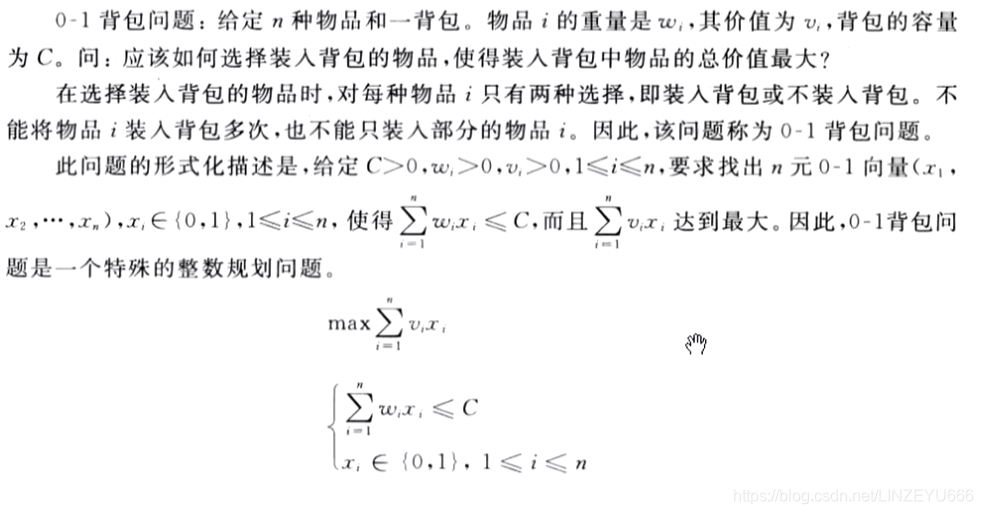295-0-1背包问题
本文共 4003 字,大约阅读时间需要 13 分钟。
0-1背包问题
要么装,要么不装!!!
不存在装一半
我们假设X序列

 我们选择从x1来缩小问题的规模
我们选择从x1来缩小问题的规模  然后我们从x2后开始,以此类推,缩小问题的规模
然后我们从x2后开始,以此类推,缩小问题的规模 最优子结构性质

我们假设c

j代表背包承受的重量,i代表放的物品。
c(i,j)代表的就是最大的价值!数学递归表达式
i==n,代表放的是第n个物品,从去来看,放的一个物品。
 我们是从头开始缩小问题规模
我们是从头开始缩小问题规模 
 表达式
表达式 
解题代码
#includeusing namespace std;int Knapsack(int W[], int V[], int i, int n, int j){ if (i == n) { return j >= W[n] ? V[n] : 0; } else if (j < W[i])//不用装了 { return Knapsack(W, V, i + 1, n, j); } else { int max1 = Knapsack(W, V, i + 1, n, j); int max2 = Knapsack(W, V, i + 1, n, j - W[i]) + V[i]; return max1 > max2 ? max1 : max2; }}int main(){ const int n = 5; const int c = 10; int W[n + 1] = { 0,2,2,6,5,4 };//0下标不放数据 ,重量 int V[n + 1] = { 0,6,3,5,4,6 };//0下标不放数据 ,最大价值 int maxv = Knapsack(W, V, 1, n, c); cout << maxv << endl;}
运行程序

换种思路:正向走


 代码如下:
代码如下: #include#include using namespace std;int Knapsack(int W[], int V[], int i, int j){ if (i == 1) { return j >= W[1] ? V[1] : 0; } else if (j < W[i]) { return Knapsack(W, V, i - 1, j); } else { int max1 = Knapsack(W, V, i - 1, j); int max2 = Knapsack(W, V, i - 1, j - W[i]) + V[i]; return max1 > max2 ? max1 : max2; }}int main(){ const int n = 5; const int c = 10; int W[n + 1] = { 0,2,2,6,5,4 };//0下标不放数据 ,重量 int V[n + 1] = { 0,6,3,5,4,6 };//0下标不放数据 ,最大价值 int maxv = Knapsack(W, V, n, c); cout << maxv << endl;}

优化
5个物品,10重量
 当物品是0个,不管背包的容量多大,价值为0,当背包的容量为0,不管多少个物品,都是0。 当我们放这5个物品,当我们的背包容量=10的时候,我们的最大价值=15。 到底哪些物品我们存放了,哪些物品我们没有存放? 从第5个物品开始看,15和14不相等,所以第5个物品我们放!它的重量是6。
当物品是0个,不管背包的容量多大,价值为0,当背包的容量为0,不管多少个物品,都是0。 当我们放这5个物品,当我们的背包容量=10的时候,我们的最大价值=15。 到底哪些物品我们存放了,哪些物品我们没有存放? 从第5个物品开始看,15和14不相等,所以第5个物品我们放!它的重量是6。  10-4=6。容量=6的时候,9和9相等,物品4,物品3没放,物品2放。
10-4=6。容量=6的时候,9和9相等,物品4,物品3没放,物品2放。 递归写法
#include#include using namespace std;void Print_Vector(vector >& c, int m, int n){ for (int i = 0; i <= m; ++i) { for (int j = 0; j <= n; ++j) { printf("%4d", c[i][j]); } printf("\n"); } printf("\n");}int Knapsack(int W[], int V[], int i, int j, vector >& dp){ if (i == 1) { dp[i][j]= j >= W[1] ? V[1] : 0; } else if (dp[i][j] > 0) { return dp[i][j]; } else if (j < W[i]) { dp[i][j] = Knapsack(W, V, i - 1, j, dp); } else { int max1 = Knapsack(W, V, i - 1, j, dp); int max2 = Knapsack(W, V, i - 1, j - W[i], dp) + V[i]; dp[i][j]= max1 > max2 ? max1 : max2; } return dp[i][j];}void BackPack(int W[], const vector >& dp, int n, int c, bool X[]){ for (int i = n; i > 0; --i) { if (dp[i][c] != dp[i - 1][c]) { X[i] = true;//放进去 c -= W[i];//减去i的重量 } }}int main(){ const int n = 5; const int c = 10; int W[n + 1] = { 0,2,2,6,5,4 }; int V[n + 1] = { 0,6,3,5,4,6 }; bool X[n + 1] = { }; vector > dp(n + 1, vector (c + 1, 0)); //n+1代表物品的个数,c+1代表重量 int maxv = Knapsack(W, V, n, c, dp); cout << maxv << endl; Print_Vector(dp, n, c); BackPack(W, dp, n, c, X); return 0;}


非递归写法
#include#include using namespace std;void Print_Vector(vector >& c, int m, int n){ for (int i = 0; i <= m; ++i) { for (int j = 0; j <= n; ++j) { printf("%4d", c[i][j]); } printf("\n"); } printf("\n");}int Knapsack(int W[], int V[], int n, int c, vector >& dp){ for (int j = 1; j <= c; ++j) { if (j >= W[1]) { dp[1][j] = V[1]; } else { dp[1][j] = 0; } } for (int i = 2; i <= n; ++i) { for (int j = 1; j <= c; ++j) { if (j < W[i]) { dp[i][j] = dp[i - 1][j]; } else { dp[i][j] = std::max(dp[i - 1][j], dp[i - 1][j - W[i]] + V[i]); } } } return dp[n][c];}void BackPack(int W[], const vector >& dp, int n, int c, bool X[]){ for (int i = n; i > 0; --i) { if (dp[i][c] != dp[i - 1][c]) { X[i] = true;//放进去 c -= W[i];//减去i的重量 } }}int main(){ const int n = 5; const int c = 10; int W[n + 1] = { 0,2,2,6,5,4 }; int V[n + 1] = { 0,6,3,5,4,6 }; bool X[n + 1] = { }; vector > dp(n + 1, vector (c + 1, 0)); //n+1代表物品的个数,c+1代表重量 int maxv = Knapsack(W, V, n, c, dp); cout << maxv << endl; Print_Vector(dp, n, c); BackPack(W, dp, n, c, X); return 0;}


转载地址:http://axyiz.baihongyu.com/
你可能感兴趣的文章
Nacos Config--服务配置
查看>>
Nacos Derby 远程命令执行漏洞(QVD-2024-26473)
查看>>
Nacos 与 Eureka、Zookeeper 和 Consul 等其他注册中心的区别
查看>>
Nacos 单机集群搭建及常用生产环境配置 | Spring Cloud 3
查看>>
Nacos 启动报错[db-load-error]load jdbc.properties error
查看>>
Nacos 报Statement cancelled due to timeout or client request
查看>>
Nacos 注册服务源码分析
查看>>
Nacos 融合 Spring Cloud,成为注册配置中心
查看>>
Nacos-注册中心
查看>>
Nacos-配置中心
查看>>
Nacos2.X 源码分析:为订阅方推送、服务健康检查、集群数据同步、grpc客户端服务端初始化
查看>>
Nacos2.X 配置中心源码分析:客户端如何拉取配置、服务端配置发布客户端监听机制
查看>>
Nacos2.X源码分析:服务注册、服务发现流程
查看>>
NacosClient客户端搭建,微服务注册进nacos
查看>>
Nacos中使用ribbon
查看>>
Nacos使用OpenFeign
查看>>
Nacos使用Ribbon
查看>>
Nacos做注册中心使用
查看>>
Nacos做配置中心使用
查看>>
Nacos入门过程的坑--获取不到配置的值
查看>>